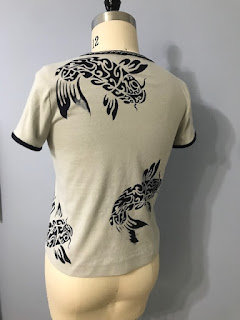The past 2 months has been busy and challenging. There has been virtually no sewing. Instead, lots of knitting.
I get such a sense of grounding and satisfaction from stepping into my sewing room and stitching. Even if I'm just repairing a terry bath towel that has come unstitched, I find pleasure. Of course, making a garment from start to finish is my preference, but even the necessary sewing is helpful at times.
During this time, we've traveled to visit grandchildren in 3 different locations, we had a sudden death in the family that necessitated a trip to TX to be with family, we had Thanksgiving plans to meet some of the grands on Fripp Island in SC.
Then I missed a step, twisted my ankle, and had surgery. Recovery is slow. I know, in my heart and mind, that I should not complain. After all, this episode of temporary disability has given me a tiny glimmer of what it would be like to suffer a permanent disability. And compassion is a good thing, no matter its source.
Then Covid Omicron visited our family and upended Christmas plans. So many people have suffered from this, many in ways so much harder than mine. But I miss seeing some local grands and their parents. It is still rolling through them and we have evidently dodged that particular bullet for now. Thank goodness for vaccines and boosters.
It is not impossible to sew with a cast from the knee down, nor is it impossible with the boot I now wear. I did manage to make a silk pillow case for DD at her request. I was lucky to have a piece in stash that was just right. And she seemed pleased.
I alternate between crutches and a knee scooter, neither of which works well moving between my ironing board and sewing machine. Maybe DH will help me re-order my sewing room to accommodate me better. He's been my hero during all of this.
Knitting, well, it turns out you can do that almost upside down. And I have been doing a lot of that, foot above heart. Talk about slow sewing. It does not get much slower than when I knit. Therefore, it is not terribly expensive and keeps me occupied.
I first learned to knit (crochet, needlepoint, embroidery, etc) as a child but it did not stick. Then when I was living in Princeton NJ in the 1980s, and desperate for the company of ladies who make, I took a knitting class. I acquired some tools and some yarn but never made anything I really loved. And life took different turns requiring my attention to career, marriage and raising kids.
There is a sweet little knit shop in the town next to my son in NH. I first learned of it because she originally had a rather large store in Nashua that was half sewing fabric and half knitting. The knitting has survived her down-sizing and move to the tiny town.
I have sewing friends who knit. They made these cool hats that you knit really large and then full in the washing machine. One friend gave me some yarn, a hat pattern, and encouragement. And I was off to learn knitting again.
That endeavor is now serving me well, though I do miss sewing garments so very much. I've learned not only how to KNIT but how to TINK (un-knit). I am fearless in the tinking. Thank goodness for youtube, my constant teacher.
I had almost finished a sweater, took it to NH to finish, and it was attacked by my son's cat. He evidently just loved to dig into that texture and lanoline. He managed to bite significant holes in it before being caught. I took it to that sweet knit shop in the next town over and asked for expert advice. She said without hesitation, rip it out.
BTW, son feels horrible about this, but I wish he did not. After all Mao was just being a cat. And I think the results are going to be so much better that the original as I improve my skills and spot major errors I made the first time around. As I un-knitted and re-knitted, I realized the large number of mistakes I had made!
Since then I've finished that wool sweater up to the sleeves and decided that I'll leave it as a vest. That yarn is unforgiving and the results are not stellar. I need to block it and maybe that'll help a little, but I don't want to invest any more time trying to save it. But I've learned so much. And I have to give credit to the author of this video for all the detailed guidance on knitting the Weekender.
I hope to make it again with a higher quality of yarn. I am realizing that, much like with sewing garments, quality in yarn makes a huge difference in the result. I love knitting merino wool, but even merino wools vary quite a lot. For this sweater I plan to use a lovely wool that has been treated to prevent shrinkage when hand-washing.
Making the classic World War II watch caps has been much more satisfying. This is primarily because I invested in some better yarn. I managed to eek out 7 of them for Christmas presents.
Since then I decided to use the yarn left over from my sweater to try a purse that will be fulled in the washer. Maybe it will work. Either way is actually OK right now.
So I wish you a very happy 2022. May it be full of creativity and love and good health! I have so many sewing projects in my head right now!























































